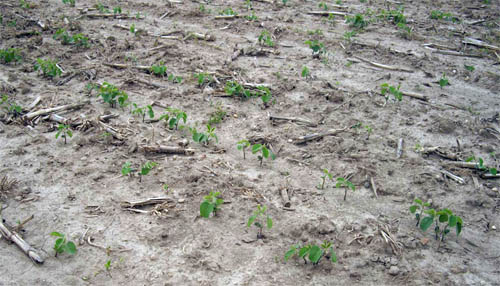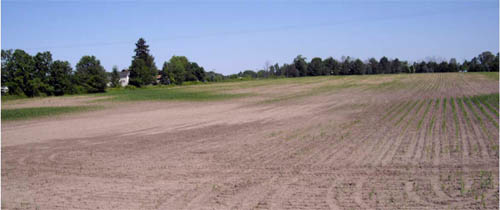Making replant decisions for corn and soybeans
The wet conditions this spring have resulted in a number of fields being candidates for replanting. Make sure to consider the full range of factors that should play into a decision to replant.
Many fields this spring have thin stands, drowned out low spots, and non-uniform growth that all force the question of whether or not to replant. While some replant decisions are easy to make, the majority are more complicated than they may first appear. A number of factors need to be considered when making replant decisions, including accurately evaluating the yield potential of the existing crop, the costs of re-establishing a field, and the yield potential of the re-sown crop. Bob Neilson with Purdue University has devised a comprehensive worksheet to make replant decisions in corn, Estimating Yield and Dollar Returns from Corn Replanting. The worksheet is lengthy, but covers many of the costs of replanting that frequently go overlooked. This tool is designed for making corn replant decisions, but the thought process and step-wise considerations are applicable for soybeans as well.
Replant decisions in soybean fields, though, are worthy of a few additional considerations. Compared to corn, the enormous ability for soybeans to compensate for low populations broadens the gap between the acceptable stand lose that can be endured and an ideal plant stand. An example of this can be seen in the photo below.

Photo 1. Thin soybean stand from poor emergence through crusted soils in Kalamazoo County.
This particular field in Kalamazoo County was planted on May 24. The heavy rains following planting resulted in a considerable soil crust and even a rotary hoe was unable to coax more than about a third of the stand out of the ground. The seeding rate was 170,000 seeds per acre, but the current stand is between 60,000 and 70,000 plants per acre in this 110 acre field. Several factors led the producer to keep the stand rather than replant. While some sizable gaps are evident in the field, most of the stand is fairly uniform.
With low populations in either soybeans or corn, large gaps in the row are a killer. The 15-inch row spacing also will help in achieving a full canopy faster than what would be possible in wide rows, making weed control in the sparse stand a bit less daunting. But the ultimate factor in the decision to not replant was the trade-off between the existing stand and a newly planted crop. Soybean stands in the 70,000 plant per acre range can still be expected to yield around 90 percent of that possible at optimal populations. Compared to the expected 30 percent yield loss from a mid-June planting date, the grower felt the hit from the low population was a better option than the yield reduction from late planting.
A few more points on replanting are worth considering this year as well. The wet conditions have contributed to poor emergence in some areas, but many fields have outright total losses in drowned spots. As these wet holes dry, it will be a viable option for some producers to selectively replant. Fields like that in photo 2 have areas of good plant vigor and margins where struggling plants still have decent yield potential, making ripping up the entire field a costly decision.

Photo 2. Variable corn stand in Ingham County.
In cases like this where selective replanting is possible, care should be taken to avoid damaging the existing stand. The low yield potential of corn replanted in a small flooded pocket often doesn’t justify injuring healthy plants getting around the field. Similarly, it’s usually not successful to “thicken up” stands on the gradient between drowned areas and healthy areas. Damaging the good plants aside, late seeded plants will serve as competition to larger plants throughout the season and with a large enough gap between the two in maturity, may ultimately act as weeds to their larger neighbors.
Finally, it’s worth considering that for some producers, making a replant decision is not simply an economic decision. Appearances matter. It can be difficult driving past some of these ugly fields and it’s understandable that their appearance is matter of personal pride. The perception of good agronomic management to landlords can also be an issue on rented acres. Many producers cited the need to maintain good relations with landlords when turning down preventative planting insurance claims and planting corn into June. Replanting to ensuring continued access to leased ground may be a factor for some growers.



 Print
Print Email
Email




